You have no items in your cart. Want to get some nice things?
Go shopping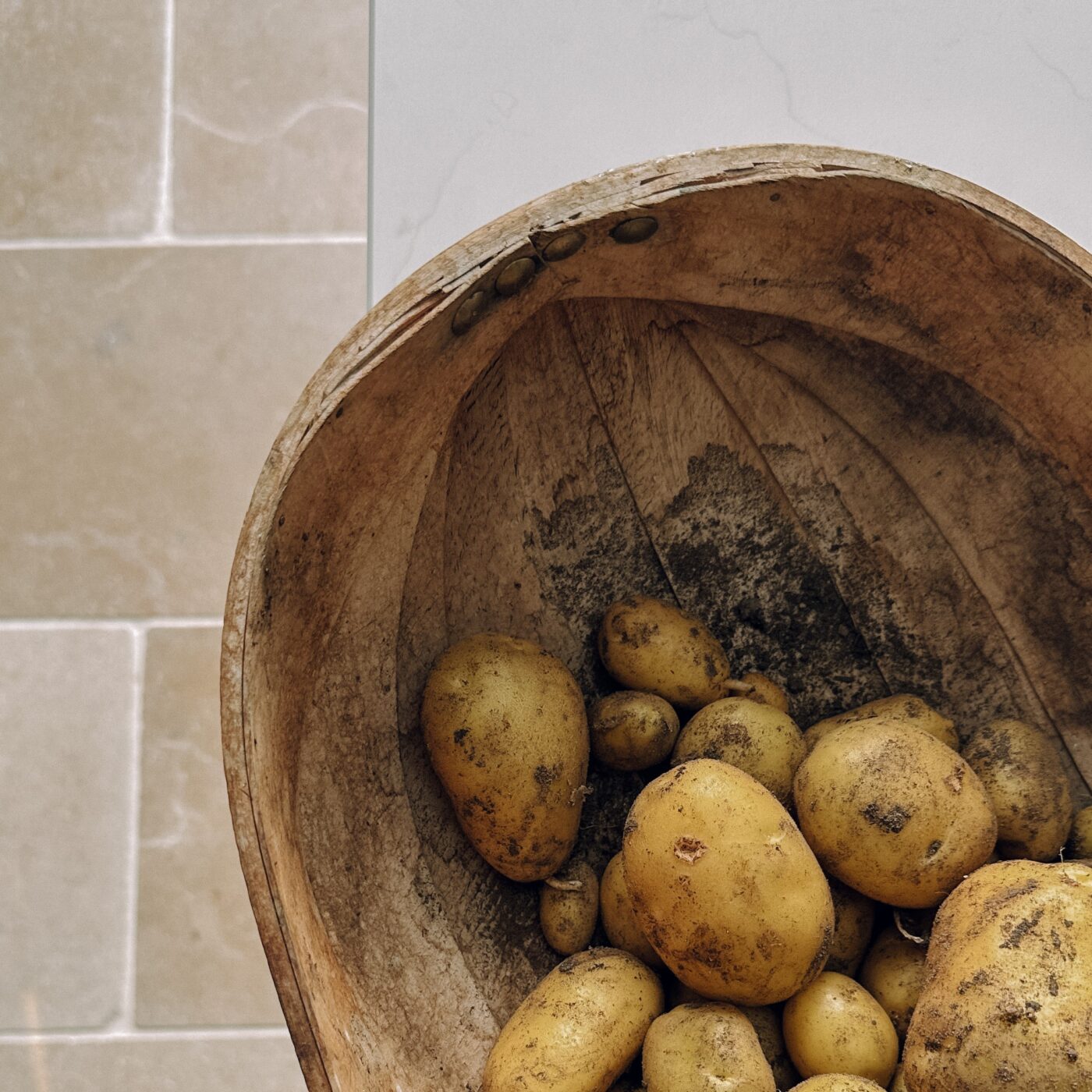
Eating in-season produce is a key part of embracing seasonal living. There are so many benefits of eating fresh, local fruits and vegetables. We explain the advantages of eating with the seasons and list the fruits and vegetables you can find in season each month in the UK.
What does it mean to eat in season?
Seasonal eating means eating food, often fresh produce like fruits and vegetables, which are harvested at the peak of their natural growing cycle.
Why eat British produce in season?
There are many benefits of eating fresh British produce which is in season:
- Support local growers and farmers to boost the local economy and celebrate and protect culinary traditions and heritage
- Reduce your carbon footprint associated with food production and transportation by avoiding out-of-season produce which needs to be transported long distances across the world
- Nutrients in produce can degrade over time, so eating the freshest produce possible that’s picked at peak ripeness means you’re not only eating tastier, more flavoursome food, but it’s better for you too
- Reconnect with the pace and patterns of the season, become more mindful of our natural environment and create moments to look forward to and savour throughout the year
Eating seasonally and supporting local producers and culinary traditions is also a key part of the slow food movement. This kickstarted the wider slow living movement and was ignited by the threat of a McDonald’s restaurant opening in the heart of Rome in the 1980s. Slow Food, the grassroots organisation behind the movement, believes in Good, Clean & Fair food for all.
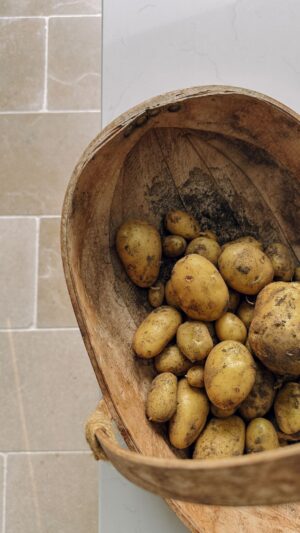
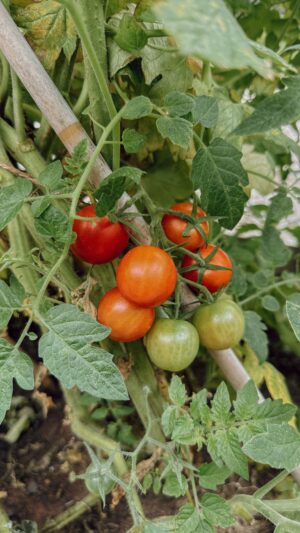
Fruits and vegetables in season by month in the UK:
January:
- Vegetables: beetroot, brussels sprouts, cauliflower, celeriac, celery, chicory, horseradish, Jerusalem artichoke, kale, kohlrabi, leeks, parsnips, potatoes (maincrop), salsify, shallots, swede, turnips
- Fruit: apples, forced rhubarb
- Foraging: chickweed, common sorrel, wild chervil
More inspiration around what’s in season in January.
February:
- Vegetables: brussels sprouts, cauliflower, celeriac, chicory, Jerusalem artichoke, kale, kohlrabi, leeks, parsnips, potatoes (maincrop), purple sprouting broccoli, salsify, shallots, swede, turnips
- Fruit: forced rhubarb
- Foraging: chickweed
More inspiration around what’s in season in February.
March:
- Vegetables: cauliflower, kale, leeks, purple sprouting broccoli, salsify, spinach, spring onions, swede, wild nettles
- Fruit: forced rhubarb
- Foraging: wild nettles, wild garlic, common sorrel, common gorse flowers
More inspiration around what’s in season in March.
April:
- Vegetables: asparagus, broccoli, jersey royal new potatoes, lettuce and salad leaves, purple sprouting broccoli, radishes, rocket, samphire, spinach, spring onions, watercress, wild nettles
- Fruit: maincrop rhubarb
- Foraging: wild garlic, garlic mustard, common mallow, wild nettles
More inspiration around what’s in season in April.
May:
- Vegetables: asparagus, broccoli, carrots, jersey royal new potatoes, lettuce and salad leaves, new potatoes, peas, radishes, rocket, samphire, spinach, spring onions, watercress
- Fruit: maincrop rhubarb
- Foraging: common sorrel, wild garlic, hawthorn flowers, wild nettles
More inspiration around what’s in season in May.
June:
- Vegetables: artichoke, asparagus, aubergine, beetroot, broad beans, broccoli, carrots, chillies, courgettes, fennel, French beans, garlic, jersey royal new potatoes, kohlrabi, lettuce and salad leaves, mangetout, new potatoes, onions, pak choi, peas, radishes, rocket, runner beans, samphire, spinach, spring onions, tomatoes, turnips, watercress
- Fruit: blueberries, cherries, gooseberries, greengages, strawberries, raspberries
- Foraging: elderflower, wild nettles
More inspiration around what’s in season in June.
July:
- Vegetables: artichoke, aubergine, beetroot, broad beans, broccoli, carrots, chillies, courgettes, fennel, French beans, garlic, jersey royal new potatoes, kohlrabi, lettuce and salad leaves, mangetout, new potatoes, onions, pak choi, peas, radishes, rocket, runner beans, samphire, spinach, spring onions, tomatoes, turnips, watercress
- Fruit: blueberries, cherries, gooseberries, greengages, strawberries, raspberries
- Foraging: bilberries
More inspiration around what’s in season in July.
August:
- Vegetables: artichoke, aubergine, beetroot, broad beans, broccoli, carrots, chillies, courgettes, cucumber, fennel, French beans, garlic, kohlrabi, lettuce and salad leaves, mangetout, marrow, onions, pak choi, peas, peppers, potatoes (maincrop), radishes, rocket, runner beans, spring onions, sweetcorn, tomatoes, turnips, watercress
- Fruit: blueberries, cherries, damsons, greengages, loganberries, plums, raspberries, redcurrants, strawberries
- Foraging: blackberries
More inspiration around what’s in season in August.
September:
- Vegetables: artichoke, aubergine, beetroot, broccoli, butternut squash, carrots, celeriac, celery, chillies, courgettes, cucumber, fennel, French beans, garlic, horseradish, kale, kohlrabi, leeks, lettuce and salad leaves, mangetout, marrow, onions, pak choi, peppers, potatoes (maincrop), pumpkin, radishes, rocket, runner beans, shallots, spring onions, sweetcorn, tomatoes, turnips, watercress
- Fruit: apples, damsons, elderberries, medlar, pears, plums, raspberries, redcurrants
- Foraging: blackberries, hawthorn berries, rosehips, elderberries, wild mushrooms
More inspiration around what’s in season in September.
October:
- Vegetables: artichoke, beetroot, broccoli, butternut squash, celeriac, celery, chicory, chillies, fennel, garlic, horseradish, jerusalem artichoke, kale, kohlrabi, leeks, lettuce and salad leaves, marrow, parsnips, potatoes (maincrop), pumpkin, radishes, rocket, runner beans, salsify, shallots, swede, sweetcorn, tomatoes, turnips, watercress
- Fruit: apples, bilberries, elderberries, medlar, pears, quince
- Foraging: hazelnuts, damsons, walnuts, chestnuts, wild mushrooms
More inspiration around what’s in season in October.
November:
- Vegetables: artichoke, beetroot, butternut squash, cauliflower, celeriac, celery, chicory, horseradish, Jerusalem artichoke, kale, kohlrabi, leeks, parsnips, potatoes (maincrop), pumpkin, salsify, shallots, swede, turnips, watercress
- Fruit: apples, pears, quince
- Foraging: chickweed, sloes, wild mushrooms
More inspiration around what’s in season in November.
December:
- Vegetables: beetroot, brussels sprouts, cauliflower, celeriac, celery, chicory, horseradish, Jerusalem artichoke, kale, kohlrabi, leeks, parsnips, potatoes (maincrop), salsify, shallots, swede, turnips
- Fruit: apples, pears
- Foraging: marsh samphire, wild mushrooms
More inspiration around what’s in season in December.
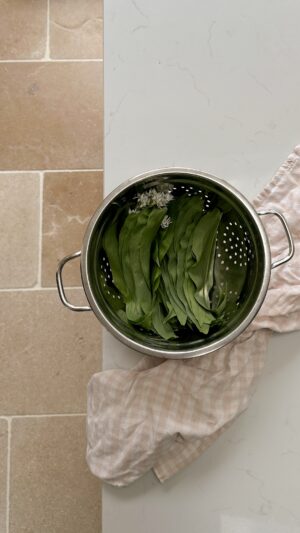
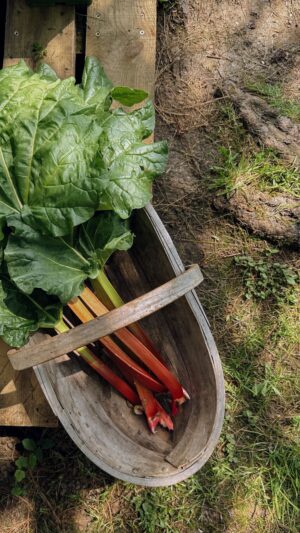
How to embrace seasonal eating
- Grow your own: Slow gardening is not only a mindful activity, it’s also a great way to reduce your environmental impact. Grow your own fruit and vegetables for garden to table eating without the need for any packaging or food miles.
- Forage: From wild garlic to chestnuts, you can forage the season’s highlights for free. Read our tips on how to forage for wild food to take part safely, legally and sustainably.
- Shop local: Support local farmers’ markets and farm shops for fresh local produce.
- Check the packaging: When buying in supermarkets, be a conscious consumer and check for the origin of the fresh produce you’re putting in your basket. Most British-grown fruits and vegetables will display a Union Jack.
- Dine at a seasonal supper club: Get inspired by what you can do with the season’s produce at a local supper club or seasonal restaurant.
More inspiration:
